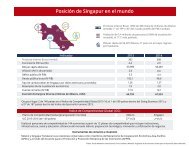basic-guide-to-exporting_Latest_eg_main_086196
basic-guide-to-exporting_Latest_eg_main_086196
basic-guide-to-exporting_Latest_eg_main_086196
You also want an ePaper? Increase the reach of your titles
YUMPU automatically turns print PDFs into web optimized ePapers that Google loves.
price is <strong>to</strong>o high, the product or service will not sell. If the price is <strong>to</strong>o low, exportactivities may not be sufficiently profitable or may actually create a net loss.The traditional components for determining proper pricing are costs, marketdemand, and competition. Each component must be compared with your company’sobjective in entering the foreign market. An analysis of each component from anexport perspective may result in export prices that are different from domestic prices.It is also very important <strong>to</strong> take in<strong>to</strong> accountadditional costs that are typically borne bythe importer. These include tariffs, cus<strong>to</strong>msWhen setting international prices,fees, currency fluctuation, transaction costsdon’t forget <strong>to</strong> fac<strong>to</strong>r in tariffs,(including shipping), and value-added taxes(VATs). These costs can add substantiallycus<strong>to</strong>ms fees, currency fluctuation,<strong>to</strong> the final price paid by the importer,transaction costs and shipping,sometimes resulting in a <strong>to</strong>tal that is more and value-added taxes.than double the price charged in the UnitedStates. U.S. products often compete betteron quality, reputation, and service than theydo on price—but buyers consider the whole package.Foreign Market ObjectivesAn important aspect of your company’s pricing analysis is the determination ofmarket objectives. For example, you may ask whether your company is attempting <strong>to</strong>penetrate a new market, seeking long-term market growth, or looking for an outletfor surplus production or outmoded products.Marketing and pricing objectives may be generalized or tailored <strong>to</strong> particular foreignmarkets. For example, marketing objectives for sales <strong>to</strong> a developing nation, whereper capita income may be one-tenth of that in the United States, necessarily differfrom marketing objectives for sales <strong>to</strong> Europe or Japan.CostsThe actual cost of producing a product and bringing it <strong>to</strong> market is key <strong>to</strong>determining if <strong>exporting</strong> is financially viable. Many new exporters calculate theirexport price by the cost-plus method. Inthat calculation, the exporter starts withthe domestic manufacturing cost and addsadministration, research and development,overhead, freight forwarding, distribu<strong>to</strong>rmargins, cus<strong>to</strong>ms charges, and profit.The effect of this pricing approach maybe that the export price escalates in<strong>to</strong> anuncompetitive range. Although an exportCarefully consider how differenttypes of cost-related pricing canaffect your competitiveness ininternational markets.148U.S. Commercial Service • A Basic Guide <strong>to</strong> Exporting





